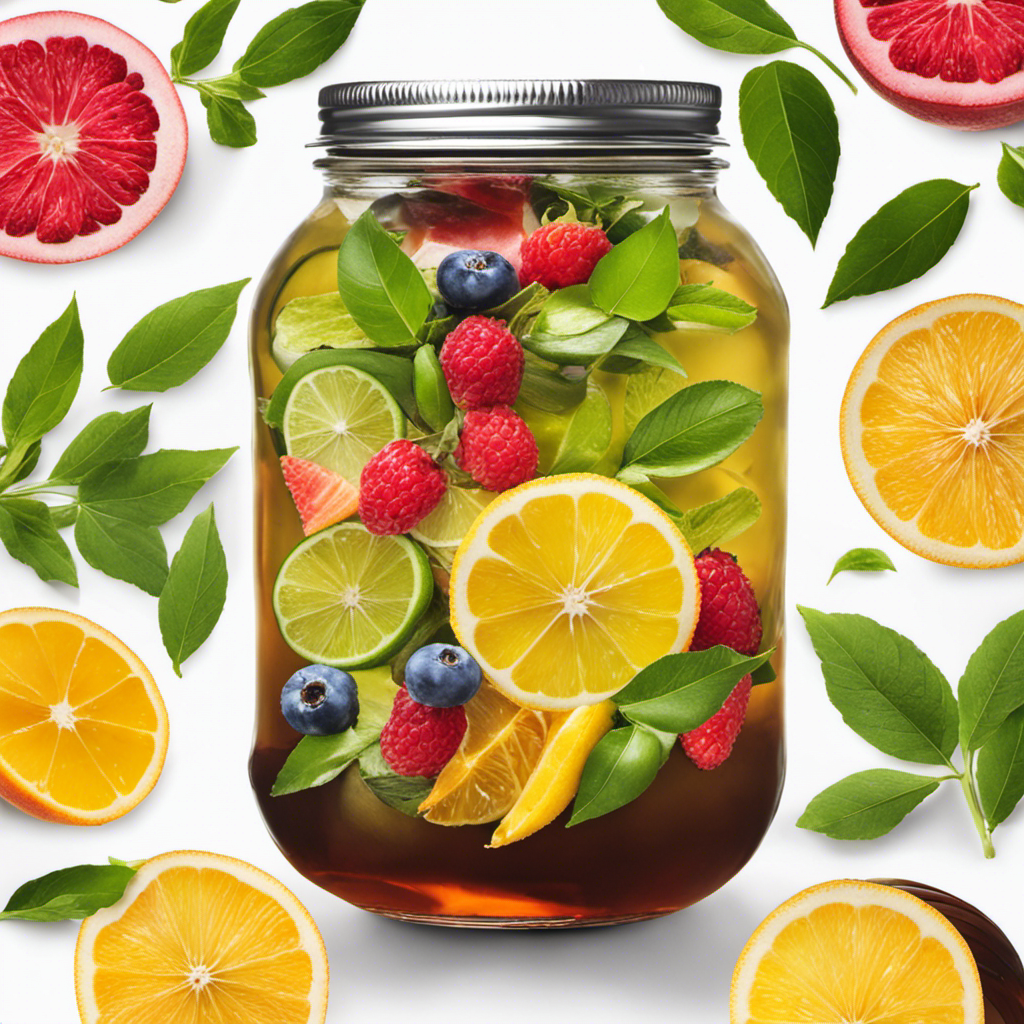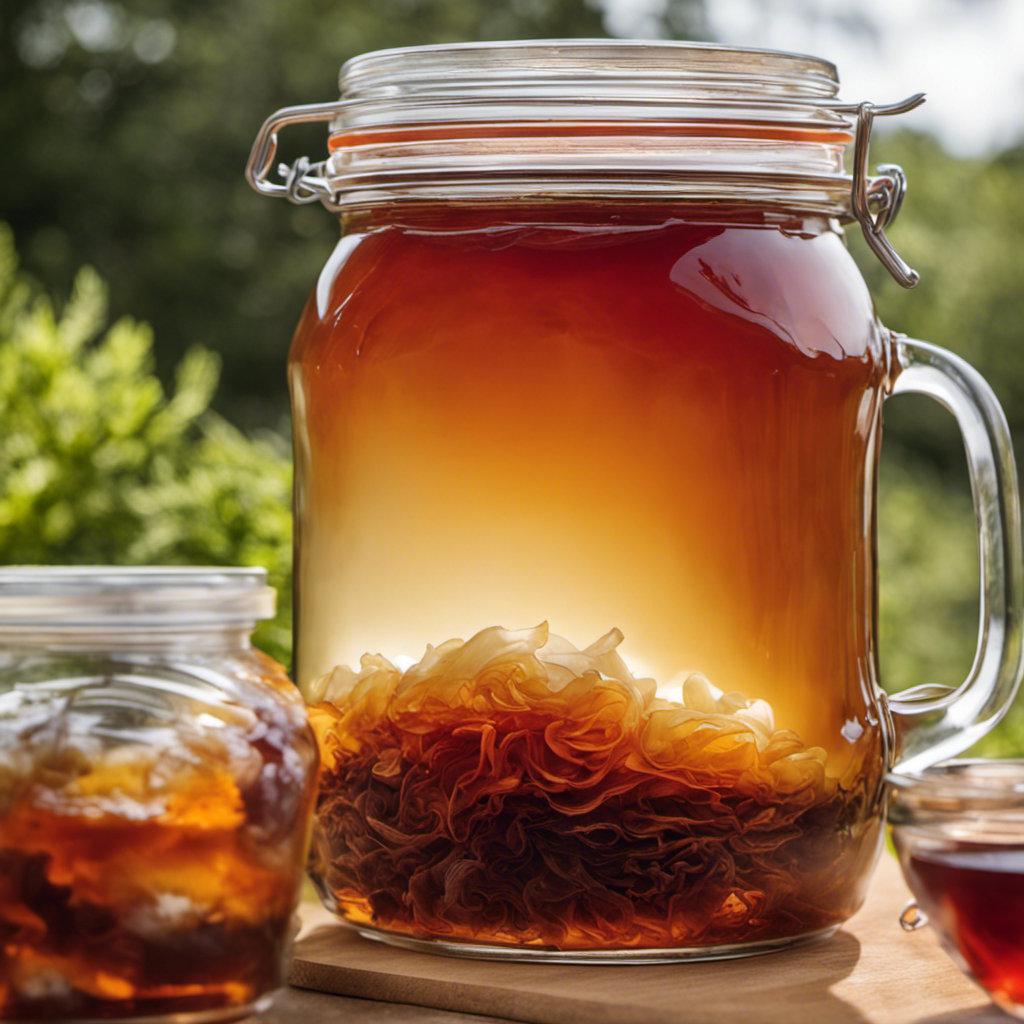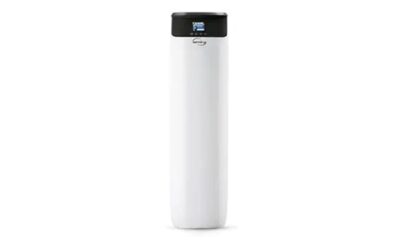Turmeric Tea
How To Make Curcumic Turmeric Tea

I absolutely love starting my day with a warm cup of curcumin turmeric tea. Not only is it delicious and comforting, but it also has numerous health benefits that make me feel energized and ready to take on the day ahead.
Curcumin, the active ingredient in turmeric, has been shown to have anti-inflammatory properties and may help reduce the risk of chronic diseases such as heart disease, cancer, and Alzheimer’s.
Plus, adding ginger to your tea can aid in digestion and boost immunity.
With all these benefits in mind, let me show you how easy it is to make this tasty and nutritious beverage at home!
Key Takeaways
- Turmeric tea has anti-inflammatory properties and can boost immunity.
- To make turmeric tea, you will need fresh turmeric root or powder, ginger, honey, lemon, and water.
- Ginger aids digestion and honey is a natural sweetener with antibacterial properties, while lemon enhances absorption of curcumin.
- Variations include enjoying the tea hot or cold, using alternative sweeteners, and adding black pepper, cinnamon, cardamom, or coconut or almond milk for different flavors.
Benefits of Curcumin Turmeric Tea
If you want to experience the amazing benefits of curcumin turmeric tea, you’ve gotta try brewing a cup for yourself! One of the most well-known benefits of this tea is its anti-inflammatory properties. Curcumin, the active ingredient in turmeric, has been shown to reduce inflammation in the body and may even be as effective as some anti-inflammatory drugs. This makes it a great choice for those with inflammatory conditions such as arthritis.
In addition to its anti-inflammatory properties, curcumin turmeric tea also provides support for the immune system. Research has shown that curcumin can help boost immunity by increasing the activity of certain immune cells. This means that drinking this tea regularly could help protect against infections and illnesses.
So, now that you know about these incredible benefits, it’s time to gather your ingredients and start brewing!
Gather Ingredients
So, to make a delicious and healthy cup of turmeric tea, the first step is to gather all the necessary ingredients. I usually go for fresh turmeric root or powder, ginger, honey, lemon, and water.
These are the key players that make this tea so nutritious and flavorful. By combining these ingredients in just the right way, you can create a drink that not only tastes great but also has remarkable health benefits.
Turmeric Root or Powder
Turmeric adds a warm and earthy flavor to your tea, whether you use fresh turmeric root or ground powder. It’s a commonly used spice in many cultures, especially in Indian and Southeast Asian cuisine. Turmeric has also gained popularity for its health benefits, such as reducing inflammation and improving brain function. Adding turmeric to your tea not only enhances the taste but also provides potential health benefits.
There are various turmeric recipes that you can try when making tea. You can use fresh turmeric root by grating it or slicing it thinly and boiling it with water for at least 10 minutes. Alternatively, you can use ground turmeric powder by adding half a teaspoon of it into hot water or milk and stirring well. Whichever method you choose, make sure to strain the liquid before serving to remove any solid particles.
Now let’s move on to the next step – ginger!
Ginger
Now, you’re probably wondering how to add a bit of zing to your brew. Let’s talk about ginger! This root has been used for centuries in traditional medicine and cooking. Adding ginger to turmeric tea not only adds flavor but also provides numerous health benefits.
Firstly, ginger is known for its anti-inflammatory properties. It can help reduce pain and swelling in the body. Secondly, it aids digestion by promoting the production of digestive enzymes and reducing nausea. Lastly, ginger has been shown to boost the immune system and fight off infections.
So, next time you make your turmeric tea, don’t forget to add a slice or two of fresh ginger!
Speaking of flavor enhancers, let’s move onto honey which not only sweetens the tea but also has its own set of health benefits.
Honey
Honey, a natural sweetener with antibacterial properties, is a delicious addition to turmeric tea that can also provide numerous health benefits. When combined with turmeric’s anti-inflammatory and antioxidant properties, honey can help combat infections and boost the immune system.
It’s important to note that not all honey is created equal, as some store-bought varieties may contain added sugars or preservatives. To reap the full benefits of honey in your turmeric tea, opt for raw, unprocessed honey from a trusted source.
Using honey in other turmeric recipes is also a great way to incorporate this natural sweetener into your diet. For example, you can add honey to homemade golden milk or use it as a glaze for roasted vegetables seasoned with turmeric.
Additionally, drinking honey-sweetened turmeric tea before bed has been shown to improve sleep quality and reduce stress levels. So next time you brew up a pot of curcumin-rich tea, don’t forget the honey!
Transitioning into the next section about ‘lemon,’ adding lemon juice to your turmeric tea not only adds a refreshing zing but also enhances the absorption of curcumin by up to 2000%.
Lemon
Adding a splash of lemon juice to your turmeric beverage can pack a punch and help you absorb the benefits of this powerful spice like never before. Lemon is known for its high vitamin C content, which acts as an antioxidant and helps in the absorption of curcumin – the active compound found in turmeric. Not only that, but lemon also adds a refreshing flavor to your drink, making it even more enjoyable.
Here are some ways you can incorporate lemon into your turmeric tea:
- Squeeze fresh lemon juice into your tea after brewing.
- Add thin slices of lemon to your tea while it’s steeping.
- Create a zesty twist by adding grated lemon zest to your turmeric tea.
- Mix in a teaspoon of honey with freshly squeezed lemon juice for added sweetness.
Aside from enhancing the flavor profile and boosting nutrient absorption, drinking lemon tea has many health benefits on its own. It’s known for its ability to aid digestion, boost immunity, and improve skin health.
In fact, there are many simple recipes available online that show how easy it is to make delicious and healthy cups of hot or cold lemon tea at home.
As we move forward in our quest for perfecting our turmeric beverage recipe, let’s not forget about another essential ingredient – water.
Water
To fully reap the health benefits of your curcumin turmeric tea, it is important to use clean and filtered water. Water plays a crucial role in hydrating our bodies and aiding in the absorption of nutrients. When making turmeric tea, water also helps to extract the beneficial compounds from the turmeric root or powder.
It is recommended to drink at least 8 glasses of water per day for optimal hydration. This is especially important when consuming beverages with diuretic properties, such as caffeine or alcohol, which can increase fluid loss. By choosing clean and filtered water when making your turmeric tea, you can ensure that you are not adding any harmful contaminants or impurities into your body. In the table below, we explore some additional benefits of staying hydrated with clean and filtered water:
| Hydration Benefits | Effects on Body |
|---|---|
| Improves digestion | Helps flush out toxins |
| Increases energy levels | Aids in weight loss |
| Promotes healthy skin | Reduces headaches |
Now that we understand the importance of using clean and filtered water when making curcumin turmeric tea, let’s move on to preparing either fresh turmeric root or powder for our beverage.
Prepare Turmeric Root or Powder
First, you’ll need to peel and grate fresh turmeric root or measure out the desired amount of turmeric powder.
Turmeric has been used for centuries in Ayurvedic medicine and has many health benefits such as reducing inflammation, boosting immunity, and aiding digestion.
Adding it to tea is a great way to incorporate it into your daily routine.
To use fresh turmeric root, simply peel the skin off with a vegetable peeler or spoon and grate it finely using a grater or food processor.
For dried turmeric powder, measure out 1-2 teaspoons per cup of water depending on how strong you like your tea.
Once you have your desired amount ready, move on to boiling water to make your delicious cup of turmeric tea.
Boil Water
As you wait for the water to boil, it’s worth taking a moment to appreciate the benefits of drinking boiled water. Boiling water kills any harmful pathogens that may be present, making it a great way to ensure that your tea is safe and healthy to drink. Additionally, boiling water is an essential step in many different types of tea-making processes, from traditional teas like black tea and green tea to herbal blends.
Once the water comes to a rolling boil, you’re ready to add your turmeric and ginger root or powder. But before we move on to that step, let’s talk about some of the different types of tea made with boiling water.
Whether you prefer classic black tea or are looking for something more adventurous like matcha or chai, there are countless varieties of tea that can be brewed using this simple technique. With so many options available, it’s easy to find a blend that suits your taste preferences and provides health benefits as well.
Add Turmeric and Ginger
Now that we’ve boiled the water, it’s time to add the key ingredients for our turmeric tea. First, I like to add a teaspoon of ground turmeric and half a teaspoon of freshly grated ginger root.
Turmeric contains an active compound called curcumin, which has powerful anti-inflammatory properties. It can help reduce pain and swelling in the body while also providing antioxidant benefits. Ginger is also known for its anti-inflammatory effects and can help with digestion and nausea.
Combining these two ingredients creates a potent combination that not only tastes delicious but also provides numerous health benefits. The turmeric tea benefits are enhanced when paired with ginger due to their synergistic effects on inflammation and digestion.
Once you’ve added both ingredients, stir well to ensure they are evenly distributed throughout the water. Now, we move on to simmering our mixture for 10-15 minutes to allow all the flavors to meld together perfectly.
Simmer for 10-15 Minutes
To fully infuse the flavors of the ginger and turmeric into the water, let it simmer for 10-15 minutes while occasionally stirring to create a warm and comforting drink that will nourish your body from the inside out. Simmering allows all of the ingredients to blend together, releasing their essential oils, antioxidants, and anti-inflammatory properties into this delicious tea.
Simmering also brings out different variations in flavor depending on how long you let it sit. If you want a milder taste, keep it at 10 minutes. But if you’re looking for something stronger and more potent, let it simmer for up to 15 minutes. Regardless of how long you choose to simmer your tea, one thing is certain – this simple step is essential in unlocking all of its health benefits. Now that your tea has finished simmering, we’re ready to move onto the next step: straining!
Strain the Tea
You’ll want to strain the ginger and turmeric tea before enjoying it. Straining the tea will remove any bits of ginger or turmeric that may have made their way into your cup.
There are a few different types of tea strainers you can use for this task, such as mesh strainers, cloth filters, or even disposable paper filters. If using a mesh strainer, simply place it over your mug or teapot and pour the tea through it. For a cloth filter, place it inside a funnel and pour the tea through it slowly. If using a paper filter, place it in a small wire basket and set it over your mug before pouring the tea through.
Whichever method you choose, be sure to press down on any remaining bits of ginger or turmeric to extract all of the flavorful liquid.
Now that you’ve strained your ginger and turmeric tea, it’s time to add some honey and lemon for extra flavor and health benefits. Simply squeeze half a lemon into your cup along with one tablespoon of honey (adjusting to taste). Stir well until everything is combined, then sit back and enjoy!
Add Honey and Lemon
Now it’s time to sweeten up our freshly strained turmeric tea! I like to add a spoonful of honey for a natural sweetener that also has some health benefits. Honey is packed with antioxidants and has been shown to have antibacterial properties. Plus, it gives the tea a lovely flavor that complements the earthy taste of turmeric.
And don’t forget to add a splash of fresh lemon juice – not only does it enhance the flavor, but it also adds some extra vitamin C to your cup!
Sweeten with Honey
Hey, if you’ve got a sweet tooth, why not add a dollop of honey to your turmeric tea? Not only will it make your tea taste better, but honey also comes with numerous health benefits.
Honey has been used for centuries as a natural remedy to treat coughs and sore throats. It’s also rich in antioxidants that help protect your body against cell damage caused by free radicals.
If you’re looking for an alternative sweetener for your turmeric tea, honey is definitely worth considering. To sweeten your turmeric tea with honey, simply add one to two teaspoons of honey into the cup before pouring in the hot water. Stir until the honey dissolves completely and enjoy! If you prefer a sweeter taste, feel free to add more honey.
Now that we’ve added some sweetness to our turmeric tea, let’s move on to the next step – adding fresh lemon juice which can enhance both its flavor and nutritional value.
Add Fresh Lemon Juice
Adding fresh lemon juice to your turmeric drink can not only enhance its flavor but also boost its nutritional value. Lemon is a great source of vitamin C, which helps the body absorb curcumin, the active compound in turmeric.
Here are three reasons why adding fresh lemon juice to your turmeric tea is a great idea:
-
Health benefits: Lemon juice contains antioxidants that can help protect the body against damage from free radicals. It’s been shown to have anti-inflammatory properties and may even help reduce the risk of heart disease.
-
Alternative options: If you don’t like the taste of honey or want to avoid added sugars, lemon juice provides a natural sweetness without any extra calories. You can also add other herbs and spices like ginger or cinnamon for additional flavor and health benefits.
-
Nutritional value: Adding lemon juice to your turmeric drink increases its vitamin C content, which supports immune function and skin health. Lemon also contains potassium, which plays an important role in regulating blood pressure.
Now that we’ve added fresh lemon juice to our turmeric tea, it’s time to serve and enjoy!
Serve and Enjoy!
To savor your delicious cup of turmeric tea, simply grab a cozy spot, take a sip, and let the warmth spread throughout your body. You may choose to add some honey or maple syrup for sweetness, or experiment with different tea variations like adding ginger or cinnamon.
For serving suggestions, you can enjoy it hot or cold and even try incorporating it into your daily routine as a healthy alternative to coffee. As you sip on your turmeric tea, take note of its rich color and aroma.
Turmeric has been used for centuries in Ayurvedic medicine due to its numerous health benefits such as reducing inflammation and boosting immunity. So sit back, relax, and indulge in this nourishing beverage.
Next up, I’ll share some additional tips on how to make the most out of your turmeric tea experience.
Additional Tips
Now that you’ve got the hang of brewing this healthy and flavorful concoction, let me give you some insider tips to really make your turmeric tea shine like a diamond in the rough.
First off, there are a variety of alternative sweeteners you can use if honey isn’t your thing. Try maple syrup or agave nectar for a different flavor profile. Stevia’s also a great option for those watching their sugar intake.
Secondly, don’t be afraid to experiment with brewing variations. Some people prefer to add black pepper or ginger for an added kick, while others like to mix in coconut milk or almond milk for a creamier texture. You can even try adding cinnamon or cardamom for an extra boost of flavor.
The possibilities are endless, so don’t be afraid to get creative and find what works best for your taste buds!
Frequently Asked Questions
Can I use ground turmeric instead of fresh turmeric root?
Yes, I prefer using ground turmeric for my turmeric tea recipe. It’s an easy and convenient alternative to fresh turmeric root. Just add 1/2 teaspoon of ground turmeric to hot water with ginger and honey for a delicious and healthy drink.
How much honey and lemon should I add to the tea?
For the perfect honey and lemon ratio in turmeric tea, I recommend adding 1 tablespoon of honey and half a lemon’s worth of juice per cup. Honey not only adds sweetness but also has antibacterial properties that enhance the health benefits of turmeric tea.
Can I make a large batch of the tea and store it in the fridge for later consumption?
Yes, I often make a large batch of curcumin tea and store it in the fridge for later consumption. To prepare curcumin tea in advance, let it cool down, transfer to an airtight container and refrigerate.
Does the tea have any potential side effects or interactions with medications?
When consuming turmeric tea, it’s important to be aware of potential side effects and drug interactions. Precautions include avoiding if pregnant or taking blood thinners. Consult with a healthcare provider before incorporating into your routine.
Can I add other herbs or spices to the tea for additional health benefits?
Adding herbs and spices to your tea can provide additional health benefits. Did you know that over 80% of the world’s population uses plants for medicinal purposes? Incorporating herbs like ginger or cinnamon can boost immunity and reduce inflammation.
Conclusion
Well, folks, that’s how I make my delicious and healthy curcumin turmeric tea! Trust me, this tea is a game-changer when it comes to overall health and wellness.
Not only does it help with inflammation and digestion, but it also boosts the immune system and promotes healthy skin. As the saying goes, ‘an apple a day keeps the doctor away,’ but in this case, a cup of turmeric tea can do wonders for your body.
So why not give it a try? With just a few simple ingredients and steps, you can easily make this tasty beverage at home. Plus, you can customize it to your liking by adding different spices or sweeteners.
So what are you waiting for? Grab some turmeric root or powder today and get brewing!
In the vast and diverse world of coffee, coffee alternatives, and tea, Olivia has found her calling. As an author and a dedicated coffee and tea aficionado, her work for Cappuccino Oracle reflects her profound love and understanding of the intricate complexities found within these beverages. Olivia’s passion for the subject serves as both a catalyst for her creativity and a connection point with her audience.
Olivia’s appreciation for coffee, coffee alternatives, and tea blossomed at an early age. She discovered that these beverages invigorated her senses and stimulated her creative spirit. From the nuanced flavors of single-origin roasts to the captivating narratives intertwined with coffee, coffee alternatives, and tea trade and culture, Olivia found an unlimited source of inspiration in her daily cup.
Her love for these beverages and her talent for storytelling eventually converged at Cappuccino Oracle. As an author, Olivia’s mission is to illuminate the intricate tapestry that makes up the world of coffee, coffee alternatives, and tea. Her articles span a diverse range of topics, encompassing everything from the unique flavors of different brews to the sociocultural history intertwined with their cultivation and consumption.
Turmeric Tea
How to Make a Big Batch of Tea for Kombucha

I am here to provide tips on how to make a large quantity of tea for your favorite kombucha.
Get ready to dive into the world of selecting the perfect tea leaves, boiling water like a pro, and steeping that goodness to perfection.
We’ll also explore the art of adding sweeteners and flavorings to elevate your brew.
So grab your kettle and let’s get brewing!
Key Takeaways
- Select high-quality loose-leaf tea for optimal flavor extraction and to avoid unwanted additives or chemicals.
- Use a digital thermometer to accurately measure water temperature, as different types of tea require specific temperatures for brewing.
- Steeping time directly affects the flavor profile of the tea, so experiment with different times to find your preferred taste.
- Gradually add your preferred sweetener, such as cane sugar, honey, agave syrup, or maple syrup, and experiment with different combinations to create unique flavors.
Selecting the Right Tea Leaves
To make a big batch of tea for kombucha, you should start by selecting the right tea leaves. Choosing the right tea is crucial for achieving the desired flavor and fermentation process.
When it comes to brewing techniques for kombucha, there are various tea brewing methods to consider. Black tea, green tea, and oolong tea are popular choices, each lending its unique flavor profile to the final product. Black tea offers a robust and bold taste, while green tea provides a lighter and grassier flavor. Oolong tea falls in between, with a slightly fruity and floral taste.
It’s important to select high-quality loose-leaf tea to ensure optimal flavor extraction and avoid any unwanted additives or chemicals.
Measuring and Boiling Water
Start by measuring and boiling water for your large quantity of kombucha. The water temperature plays a crucial role in the brewing process, as it affects the extraction of flavors from the tea leaves. To ensure accuracy, I recommend using a digital thermometer to measure the water temperature. Different types of tea leaves require different water temperatures for optimal brewing. Refer to the table below for the recommended water temperatures for various tea varieties:
| Tea Type | Water Temperature |
|---|---|
| Green Tea | 160-180°F |
| Black Tea | 200-212°F |
| Oolong Tea | 190-200°F |
| White Tea | 180-190°F |
| Herbal Tea | 200°F |
Once you have measured the water and reached the appropriate temperature, bring it to a boil. Boiling the water helps to remove impurities and sterilize it, ensuring a clean and safe brewing environment for your kombucha. Remember to let the water cool before adding the tea leaves to avoid scorching them.
Steeping the Tea
Once the water has reached the appropriate temperature, you can begin steeping the tea leaves to extract their flavors. Steeping time and temperature control are crucial factors in achieving the perfect cup of tea. Here are three key points to consider:
-
Steeping time: The length of time the tea leaves are steeped directly affects the flavor profile of the tea. For black tea, a steeping time of 3-5 minutes is recommended, while green tea requires a shorter steeping time of 2-3 minutes. Herbal teas, on the other hand, can be steeped for 5-7 minutes to bring out their natural flavors.
-
Temperature control: Different types of tea require specific water temperatures for optimal flavor extraction. Black teas should be steeped in water that has been heated to around 95°C (203°F), while green teas are best steeped in water that is slightly cooler, around 80°C (176°F). Herbal teas can be steeped in water that has been heated to boiling point.
-
Experimentation: Finding the perfect steeping time and temperature for your personal taste preferences may require some trial and error. Don’t be afraid to adjust the variables until you find the combination that suits you best.
Adding Sweeteners and Flavorings
When sweetening your tea, remember to add your preferred sweetener gradually, stirring and tasting until it reaches your desired level of sweetness.
There are different types of sweeteners that can be used for kombucha, each bringing its own unique flavor profile. Some popular options include cane sugar, honey, agave syrup, and maple syrup.
Cane sugar is commonly used and provides a clean, neutral taste. Honey adds a floral and slightly fruity note to the kombucha. Agave syrup adds a subtle sweetness with a hint of caramel flavor. Maple syrup brings a rich and earthy taste to the brew.
Experimenting with different sweeteners can lead to creative flavor combinations for kombucha. For example, combining honey and ginger can create a refreshing and spicy flavor, while using maple syrup and vanilla can result in a sweet and indulgent taste.
The possibilities are endless when it comes to adding sweeteners and flavorings to your kombucha.
Cooling and Storing the Brewed Tea
To cool and store your brewed tea, you’ll want to transfer it to a clean and airtight container, allowing it to cool at room temperature before placing it in the refrigerator.
Here are three important things to keep in mind when storing brewed tea:
-
Temperature control: It is crucial to maintain the temperature of brewed tea to ensure its quality and taste. Rapid temperature changes can affect the flavor and potentially spoil the tea. Allowing it to cool at room temperature before refrigerating prevents any drastic fluctuations.
-
Clean container: Using a clean and airtight container is essential to prevent any contamination. Make sure to wash the container thoroughly before transferring the tea to avoid any lingering flavors or bacteria.
-
Refrigerate promptly: Once the tea has cooled at room temperature, place it in the refrigerator as soon as possible. Refrigeration slows down the growth of bacteria and helps preserve the freshness and flavor of the tea.
Frequently Asked Questions
How Long Does It Take for Kombucha to Ferment After Adding the Brewed Tea?
After adding the brewed tea, kombucha typically takes 7-10 days to ferment. However, fermentation duration can vary depending on factors such as temperature and desired taste. Troubleshooting fermentation issues may involve adjusting brewing time or temperature.
Can I Use Flavored Tea Leaves for Making Kombucha?
Yes, flavored tea leaves can be used to make kombucha. They add a unique taste to the final brew. However, it’s important to choose teas without additives or oils that can harm the SCOBY. Alternative tea options include green, black, white, and oolong varieties.
Is It Necessary to Use Filtered Water for Brewing Kombucha?
Using tap water for brewing kombucha is possible, but using filtered water offers several benefits. Filtered water removes impurities and chlorine that can potentially harm the SCOBY and affect the flavor of the final product.
Can I Use Herbal Tea Leaves Instead of Black or Green Tea Leaves?
Using herbal tea leaves for kombucha brewing is possible, but not recommended. Black or green tea leaves provide necessary nutrients for the SCOBY to ferment properly. Different tea varieties can add unique flavors and health benefits to kombucha.
What Is the Ideal Temperature for Fermenting Kombucha?
The ideal temperature for fermenting kombucha is between 75-85 degrees Fahrenheit. Maintaining this temperature range is crucial for the growth of beneficial bacteria and yeast, ensuring a successful fermentation process.
Conclusion
In conclusion, brewing a big batch of tea for kombucha is like harnessing the power of nature in a single glass. By carefully selecting the right tea leaves and steeping them in boiling water, you unlock the potential for a delicious and healthful beverage.
Adding sweeteners and flavorings is like sprinkling magic into the mix, enhancing the taste and creating a truly unique experience.
And finally, cooling and storing the brewed tea ensures that its flavors develop and mature, ready to be enjoyed whenever you desire.
So go forth, embrace the art of kombucha brewing, and sip on the elixir that nature has to offer.
Noah, the Editor-in-Chief at Cappuccino Oracle, plays a pivotal role in shaping the voice and vision of our renowned platform. With an unwavering passion for coffee, coffee alternatives, and tea, Noah leads Cappuccino Oracle towards new horizons in the realm of coffee journalism.
Beyond his professional responsibilities, Noah serves as a mentor and guiding force for his team. His dedication to journalistic excellence and genuine love for coffee, coffee alternatives, and tea continue to inspire and motivate the Cappuccino Oracle family. In the ever-evolving world of these beverages, Noah’s leadership ensures that our platform remains at the forefront, delivering enlightening and enjoyable content to our readers worldwide.
Turmeric Tea
How Do Scoby Convert Tea to Kombucha

As I observe the graceful movement of the scoby in my fermenting vessel, I am astonished by the ability of this living organism to turn a basic cup of tea into a tangy and bubbly drink called kombucha.
In this article, I will delve into the fascinating world of kombucha fermentation and explore the role of the scoby in converting the tea into this probiotic-rich beverage.
We will uncover the factors that influence the scoby’s ability to perform this alchemical conversion and discover tips and tricks for achieving optimal tea to kombucha conversion.
Key Takeaways
- The scoby is essential for the fermentation process of kombucha, as it metabolizes sugars in the tea and produces organic acids, vitamins, and enzymes.
- Factors such as fermentation time, temperature, and tea-to-sugar ratio can affect the flavor and acidity of the final kombucha product.
- The scoby interacts with various components in tea, including caffeine, tannins, polyphenols, and sugars, enhancing the aromatics and adding complexity to the kombucha.
- To achieve optimal tea to kombucha conversion, it is important to use the proper temperature and steeping time for different types of tea, ensure water is free from contaminants, experiment with different tea blends, and get creative with unique flavors.
The Role of Scoby in Kombucha Fermentation
The scoby plays a crucial role in converting tea into kombucha. During the fermentation process, the scoby, which stands for ‘symbiotic culture of bacteria and yeast,’ acts as a living organism that metabolizes the sugars present in the tea. This metabolic activity results in the production of various compounds, including organic acids, vitamins, and enzymes, which give kombucha its unique flavor and health benefits.
Without the scoby, fermentation would not occur, and tea would remain just tea. The scoby acts as a biofilm, providing a surface for the microorganisms to adhere to and grow. It also creates a controlled environment by regulating the pH and oxygen levels, ensuring the optimal conditions for fermentation.
Therefore, the scoby is of utmost importance in kombucha production, as it drives the fermentation process and contributes to the transformation of tea into the tangy and fizzy beverage we know as kombucha.
In the following section, we will delve into the conversion process: tea to kombucha.
The Conversion Process: Tea to Kombucha
During fermentation, black or green tea mixed with sugar and the scoby undergoes a process that turns it into kombucha. This conversion process involves the interaction of various microorganisms that transform the tea and sugar mixture into a tangy and fizzy beverage.
To enhance the flavors of kombucha, different brewing techniques can be employed. These techniques include increasing the fermentation time, adjusting the temperature, and experimenting with different tea-to-sugar ratios. By manipulating these factors, a stronger and more complex flavor profile can be achieved.
Additionally, the type of tea used in kombucha fermentation can greatly impact the taste of the final product. Exploring different types of tea, such as black, green, oolong, or white tea, can result in unique kombucha flavors, ranging from earthy and robust to light and floral.
Factors Affecting Scoby’s Conversion of Tea to Kombucha
To enhance the flavors of your kombucha, you can experiment with different brewing techniques such as adjusting the fermentation time, temperature, and tea-to-sugar ratios. These factors greatly influence the fermentation process and can have a significant impact on the flavor profile of your kombucha. The fermentation time determines how long the bacteria and yeast in the scoby have to convert the tea and sugar into kombucha. This can range from 7 to 30 days, depending on your desired flavor and acidity. The temperature at which you ferment your kombucha also affects the flavor. Higher temperatures (around 80°F) result in a faster fermentation process and a more acidic flavor, while lower temperatures (around 70°F) produce a milder and smoother taste. Lastly, adjusting the tea-to-sugar ratio can alter the flavor intensity. A higher sugar content will yield a sweeter kombucha, while a lower sugar content will result in a more tart and tangy beverage.
| Factors Influencing Fermentation Process | Scoby’s Impact on Flavor Profile |
|---|---|
| Fermentation time | Sweetness and acidity |
| Temperature | Intensity of flavor |
| Tea-to-sugar ratio | Tartness and tanginess |
Understanding Scoby’s Interaction With Tea Components
When experimenting with brewing techniques, you can observe how different components in the tea interact with the scoby to create unique flavors. The scoby’s microbial ecosystem plays a crucial role in the fermentation process, breaking down the tea’s components and transforming them into kombucha.
Here’s a breakdown of the scoby’s interaction with tea components:
-
Caffeine: The scoby’s enzymes act on caffeine, breaking it down and reducing its concentration in the final brew.
-
Tannins: Tannins give tea its astringency. The scoby interacts with tannins, mellowing their flavor and reducing their impact on the kombucha’s taste.
-
Polyphenols: These compounds contribute to the tea’s antioxidant properties. The scoby metabolizes polyphenols, releasing flavorful metabolites and adding complexity to the kombucha.
-
Sugars: The scoby consumes sugars present in the tea, producing carbon dioxide and ethanol as byproducts.
-
Aromatics: The scoby’s fermentation process enhances the aromatics of the tea, resulting in a rich and diverse flavor profile.
Understanding these interactions allows brewers to manipulate the brewing process and create kombucha with varying flavors and characteristics.
Tips and Tricks for Optimal Tea to Kombucha Conversion
For the best results, it’s important to ensure the proper conversion of tea into kombucha by following these tips and tricks.
When it comes to brewing techniques, it’s crucial to use the right temperature and steeping time for your tea. Different types of tea require different brewing parameters, so be sure to research and follow the recommendations for each specific variety.
Additionally, pay attention to the quality of your water and make sure it is free from chlorine and other contaminants that can hinder the fermentation process.
As for flavor profiles, experiment with different tea blends to find the perfect combination that suits your taste buds. Some popular options include green tea, black tea, and herbal infusions. Don’t be afraid to get creative and try unique flavors like jasmine or earl grey.
Frequently Asked Questions
How Long Does It Take for the Scoby to Convert Tea Into Kombucha?
It takes several factors into account when determining how long it takes for the scoby to convert tea into kombucha. The presence of oxygen plays a crucial role in this conversion process.
Can I Use Any Type of Tea for Making Kombucha?
Using different types of tea for making kombucha can yield unique flavors and benefits. Green tea is commonly used, with its antioxidants and caffeine. Black tea provides a stronger flavor and more tannins, which aid in fermentation.
What Are the Signs That the Scoby Is Actively Converting Tea Into Kombucha?
Signs of active fermentation include the formation of a new scoby, a tangy taste, and the release of carbon dioxide bubbles. Kombucha benefits gut health due to the probiotics and organic acids it contains.
Can I Speed up the Conversion Process by Adding More Scoby to the Tea?
Adding more scoby to the tea may speed up the fermentation process. The benefits of using multiple scobies include increased microbial activity and a faster conversion of tea to kombucha.
Is There a Specific Temperature Range That Is Ideal for Scoby to Convert Tea Into Kombucha?
The ideal temperature range for scoby fermentation depends on several factors. Factors that can affect scoby’s ability to convert tea into kombucha include temperature, pH level, oxygen availability, and sugar content.
Conclusion
In conclusion, the role of Scoby in converting tea to kombucha is essential for the fermentation process.
Through its interaction with various components in tea, Scoby undergoes a complex conversion process that results in the creation of this popular fermented beverage.
Factors such as temperature, time, and tea quality can affect Scoby’s ability to convert tea effectively.
By understanding these interactions and implementing proper techniques, one can achieve optimal tea to kombucha conversion.
So, remember to maintain the right conditions and give your Scoby the best tea to ensure a successful fermentation process.
Noah, the Editor-in-Chief at Cappuccino Oracle, plays a pivotal role in shaping the voice and vision of our renowned platform. With an unwavering passion for coffee, coffee alternatives, and tea, Noah leads Cappuccino Oracle towards new horizons in the realm of coffee journalism.
Beyond his professional responsibilities, Noah serves as a mentor and guiding force for his team. His dedication to journalistic excellence and genuine love for coffee, coffee alternatives, and tea continue to inspire and motivate the Cappuccino Oracle family. In the ever-evolving world of these beverages, Noah’s leadership ensures that our platform remains at the forefront, delivering enlightening and enjoyable content to our readers worldwide.
Turmeric Tea
How Much Fat Is in Kombucha Tea

I am constantly seeking out low-fat beverages to maintain my health. That’s why I was curious to explore the benefits of kombucha tea.
In this article, we’ll dive into the nutritional profile of kombucha tea and explore its fat content. I’ll also share the health benefits of this popular drink and compare its fat content to other beverages.
So, if you’re curious about how much fat is in kombucha tea and how it fits into a low-fat diet, keep reading!
Key Takeaways
- Kombucha tea has a low-fat content, with less than 1 gram of fat per cup.
- It is also low in calories, with an average of 30 calories per cup, making it suitable for weight management.
- Kombucha tea is a probiotic powerhouse, supporting a healthy gut and digestion.
- Compared to high-fat beverages like soda and fruit juice, kombucha is a healthier option for reducing fat intake.
The Nutritional Profile of Kombucha Tea
You’ll be interested to know that kombucha tea has a low-fat content. This makes it a great beverage option for those who are looking to lose weight or maintain a healthy weight. In fact, a cup of kombucha tea typically contains less than 1 gram of fat.
This low fat content is one of the reasons why kombucha tea is often recommended as a healthier alternative to sugary drinks or high-fat beverages. Additionally, kombucha tea is also low in calories, with an average of 30 calories per cup.
This combination of low fat and low calorie content makes kombucha tea a suitable choice for individuals who are watching their weight. Understanding the fat content in kombucha tea is important in order to make informed choices about your diet and overall health.
Understanding the Fat Content in Kombucha Tea
Understanding the amount of fat in kombucha tea can be beneficial when it comes to managing your weight. Fortunately, kombucha tea is virtually fat-free, making it a great choice for those looking to shed some pounds. With its low fat content, kombucha tea can be a valuable addition to a weight loss plan.
This fermented beverage is made from tea, sugar, and a symbiotic culture of bacteria and yeast (SCOBY), which act together to create a tangy, fizzy drink. The fermentation process breaks down the sugars in the tea, resulting in a beverage that is low in calories and fat. So, if you’re watching your fat intake while trying to lose weight, kombucha tea can be a refreshing and guilt-free option.
Now that we’ve explored the fat content of kombucha tea, let’s delve into its numerous health benefits.
Exploring the Health Benefits of Kombucha Tea
If you’re looking to improve your overall health, exploring the benefits of kombucha tea can be a great place to start. Not only is it a refreshing beverage, but it also offers numerous health benefits.
Here are four reasons why you should consider incorporating kombucha tea into your daily routine:
-
Probiotic Powerhouse: Kombucha tea is fermented using a SCOBY (Symbiotic Culture of Bacteria and Yeast), which results in the production of beneficial bacteria and yeast. These probiotics can support a healthy gut and improve digestion.
-
Immune Boosting: The fermentation process of kombucha tea produces organic acids, such as acetic acid and gluconic acid, which have antimicrobial properties and can help strengthen the immune system.
-
Detoxification: Kombucha tea contains antioxidants and enzymes that aid in the detoxification process by supporting the liver’s natural detoxifying abilities.
-
Potential Health Benefits: Some studies suggest that kombucha tea may have potential benefits such as reducing inflammation, improving heart health, and supporting mental health.
Overall, kombucha tea can be a delicious and beneficial addition to your daily routine, thanks to its fermentation process and probiotic properties.
How Does Kombucha Tea Compare to Other Beverages in Terms of Fat
When it comes to comparing kombucha tea to other beverages, you’ll find that it generally has a lower fat content. This makes kombucha a healthier option for those who are watching their fat intake.
Let’s take a closer look at how kombucha compares to soda and fruit juice in terms of fat content.
Soda is known for being high in sugar and calories, but it also tends to have a higher fat content compared to kombucha. This is because soda often contains added fats like high fructose corn syrup, which can contribute to weight gain and other health issues.
On the other hand, fruit juice can vary in its fat content depending on the type and brand. While some fruit juices may contain small amounts of fat, it is generally lower than what you would find in soda. However, when compared to kombucha, fruit juice can still have a higher fat content.
Overall, if you’re looking to reduce your fat intake, opting for kombucha over soda or fruit juice can be a wise choice.
Tips for Incorporating Kombucha Tea Into a Low-Fat Diet
To incorporate kombucha into a low-fat diet, try adding a splash of it to your morning smoothie for a tangy twist. Here are four tips for incorporating kombucha tea into a low-fat diet:
-
Swap out sugary beverages: Replace high-fat drinks like soda or sugary juices with kombucha. Not only does kombucha have a lower fat content, but it also provides a refreshing and healthier alternative.
-
Use it as a marinade: Kombucha can be used as a flavorful marinade for meats and vegetables. Its tangy taste adds a unique twist to your dishes without adding unnecessary fat.
-
Make kombucha popsicles: Freeze kombucha into popsicle molds for a delicious and low-fat treat. It’s a great way to satisfy your sweet tooth without compromising your diet.
-
Mix it into dressings: Create a low-fat salad dressing by combining kombucha with olive oil, herbs, and spices. It adds a zesty flavor while keeping the fat content low.
Incorporating kombucha tea into a low-fat diet not only helps reduce fat intake but also provides numerous health benefits. Its probiotic properties support a healthy gut and immune system. Compared to other high-fat beverages, kombucha is a smart choice for those looking to maintain a low-fat diet.
Frequently Asked Questions
Can Drinking Kombucha Tea Help With Weight Loss?
Drinking kombucha tea may aid in weight loss. It’s believed to boost metabolism and reduce appetite. However, scientific evidence is limited, and other factors like diet and exercise play a significant role in overall effectiveness.
Is Kombucha Tea High in Calories?
Kombucha tea is a low-calorie beverage that can be enjoyed guilt-free. It contains minimal fat content, making it a healthy choice for those watching their calorie intake. So, go ahead and sip away!
Can Kombucha Tea Replace Other High-Fat Beverages in My Diet?
Kombucha tea can be a low-fat alternative to high-fat beverages in your diet. It is beneficial for weight management as it contains minimal fat content, making it a healthier choice.
Can Kombucha Tea Be a Part of a Low-Carb Diet?
Yes, kombucha tea can be a part of a low-carb diet. It has many benefits, such as aiding in weight loss and promoting ketosis. Incorporating kombucha into your diet can help you achieve your low-carb goals.
What Are the Potential Side Effects of Drinking Kombucha Tea?
Potential side effects of drinking kombucha tea include upset stomach, allergic reactions, and lactic acidosis. These health risks can be minimized by consuming it in moderation and ensuring the tea is properly brewed and stored.
Conclusion
In conclusion, after exploring the nutritional profile and fat content of kombucha tea, it’s evident that this fermented drink is an excellent choice for those following a low-fat diet.
With zero grams of fat per serving, kombucha tea provides a refreshing and healthy alternative to other high-fat beverages.
Its numerous health benefits, such as promoting gut health and boosting the immune system, make it a worthy addition to any diet.
So why not raise a glass of kombucha tea and toast to a healthier you?
Justin is a seasoned author, coffee and tea enthusiast, and an essential member of the Cappuccino Oracle team. With a keen appreciation for the complexities of coffee, coffee alternatives, and tea, Justin has dedicated his professional career to exploring these realms and sharing his insights with readers worldwide.
Justin’s immersion in the world of coffee, coffee alternatives, and tea began at a young age, kindling a passion that extended beyond mere consumption. This love for these beverages led him to combine his talent for writing with his devotion to coffee and tea, bringing him to Cappuccino Oracle as a dedicated author.
-

 Americano3 weeks ago
Americano3 weeks agoHow to Make Korean Iced Americano
-

 Americano2 days ago
Americano2 days agoHow to Make Americano With Delonghi Magnifica
-

 Americano2 weeks ago
Americano2 weeks agoHow to Make an Iced Americano With Nespresso
-

 Americano4 weeks ago
Americano4 weeks agoHow Many Shots of Espresso for 16 Oz Americano
-

 Turmeric Tea3 weeks ago
Turmeric Tea3 weeks agoTurmeric Saffron Tea
-

 Americano3 weeks ago
Americano3 weeks agoWhat Does Papa Americano Mean
-

 Americano10 hours ago
Americano10 hours agoHow Many Shots of Espresso Are in a 12 Oz Americano
-

 Americano3 weeks ago
Americano3 weeks agoIn What Movies Was We No Speak Americano
































